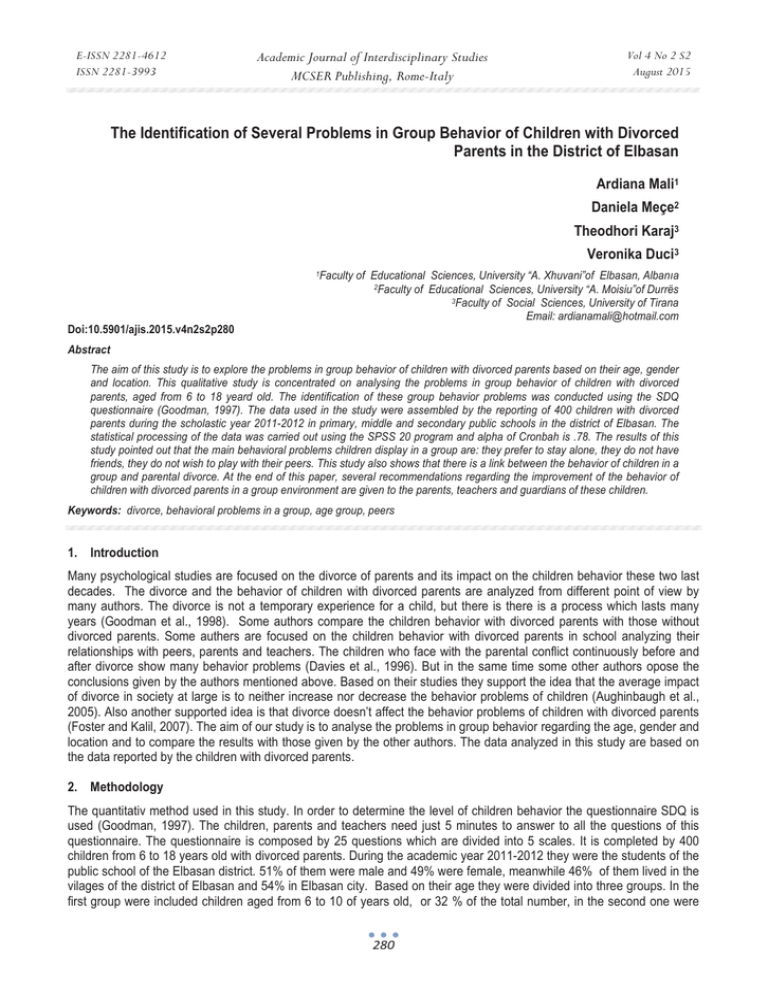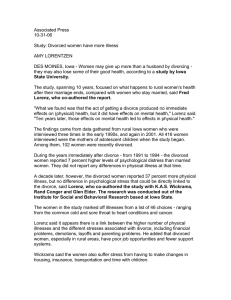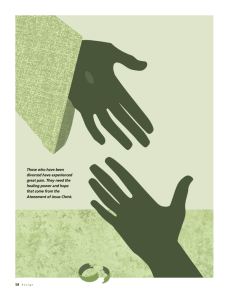The Identification of Several Problems in Group Behavior of Children... Parents in the District of Elbasan
advertisement

E-ISSN 2281-4612 ISSN 2281-3993 Academic Journal of Interdisciplinary Studies MCSER Publishing, Rome-Italy Vol 4 No 2 S2 August 2015 The Identification of Several Problems in Group Behavior of Children with Divorced Parents in the District of Elbasan Ardiana Mali1 Daniela Meçe2 Theodhori Karaj3 Veronika Duci3 1 Faculty of Educational Sciences, University “A. Xhuvani”of Elbasan, AlbanÕa 2Faculty of Educational Sciences, University “A. Moisiu”of Durrës 3Faculty of Social Sciences, University of Tirana Email: ardianamali@hotmail.com Doi:10.5901/ajis.2015.v4n2s2p280 Abstract The aim of this study is to explore the problems in group behavior of children with divorced parents based on their age, gender and location. This qualitative study is concentrated on analysing the problems in group behavior of children with divorced parents, aged from 6 to 18 yeard old. The identification of these group behavior problems was conducted using the SDQ questionnaire (Goodman, 1997). The data used in the study were assembled by the reporting of 400 children with divorced parents during the scholastic year 2011-2012 in primary, middle and secondary public schools in the district of Elbasan. The statistical processing of the data was carried out using the SPSS 20 program and alpha of Cronbah is .78. The results of this study pointed out that the main behavioral problems children display in a group are: they prefer to stay alone, they do not have friends, they do not wish to play with their peers. This study also shows that there is a link between the behavior of children in a group and parental divorce. At the end of this paper, several recommendations regarding the improvement of the behavior of children with divorced parents in a group environment are given to the parents, teachers and guardians of these children. Keywords: divorce, behavioral problems in a group, age group, peers 1. Introduction Many psychological studies are focused on the divorce of parents and its impact on the children behavior these two last decades. The divorce and the behavior of children with divorced parents are analyzed from different point of view by many authors. The divorce is not a temporary experience for a child, but there is there is a process which lasts many years (Goodman et al., 1998). Some authors compare the children behavior with divorced parents with those without divorced parents. Some authers are focused on the children behavior with divorced parents in school analyzing their relationships with peers, parents and teachers. The children who face with the parental conflict continuously before and after divorce show many behavior problems (Davies et al., 1996). But in the same time some other authors opose the conclusions given by the authors mentioned above. Based on their studies they support the idea that the average impact of divorce in society at large is to neither increase nor decrease the behavior problems of children (Aughinbaugh et al., 2005). Also another supported idea is that divorce doesn’t affect the behavior problems of children with divorced parents (Foster and Kalil, 2007). The aim of our study is to analyse the problems in group behavior regarding the age, gender and location and to compare the results with those given by the other authors. The data analyzed in this study are based on the data reported by the children with divorced parents. 2. Methodology The quantitativ method used in this study. In order to determine the level of children behavior the questionnaire SDQ is used (Goodman, 1997). The children, parents and teachers need just 5 minutes to answer to all the questions of this questionnaire. The questionnaire is composed by 25 questions which are divided into 5 scales. It is completed by 400 children from 6 to 18 years old with divorced parents. During the academic year 2011-2012 they were the students of the public school of the Elbasan district. 51% of them were male and 49% were female, meanwhile 46% of them lived in the vilages of the district of Elbasan and 54% in Elbasan city. Based on their age they were divided into three groups. In the first group were included children aged from 6 to 10 of years old, or 32 % of the total number, in the second one were 280 Academic Journal of Interdisciplinary Studies MCSER Publishing, Rome-Italy E-ISSN 2281-4612 ISSN 2281-3993 Vol 4 No 2 S2 August 2015 included 39.8% of them aged from 11-14 years old and the rest, 28.2% belongs to the group three aged from 15 to 18 years old. The statistical processing of the data was carried out using the SPSS 20 program and alpha of Cronbah was .78. The minimum of points accumulated by respondents is 5, meanwhile the maximum is 15. 3. Results and Discussions Table 1. Statistical data about the problems in group behavior reported by children Points 5.00 6.00 7.00 8.00 9.00 Valid 10.00 11.00 12.00 13.00 14.00 Total Frequency 10 22 116 80 38 15 65 48 5 1 400 Percentage 2.5 5.5 29.0 20.0 9.5 3.8 16.3 12.0 1.3 .3 100.0 Valid percentage 2.5 5.5 29.0 20.0 9.5 3.8 16.3 12.0 1.3 .3 100.0 Cumulative percentage 2.5 8.0 37.0 57.0 66.5 70.3 86.5 98.5 99.8 100.0 In the table 1 clearly are shown the data reported by 400 children. 228 children or 57% of them belongs to the normal level who have accumulated from 5-8 points, meanwhile 118 children or 29.5% have accumulated 9-11 points and belongs to the level in the border of abnormal and the rest, 54 children or 13.5% belongs to the abnormal level, from 12 to 15 points. 4. Problems in group behavior based on the gender Table 2. Statistical data about the problems in group behavior based on the gender Points Female Gender Male Total N of chil % Total N of chil % Total N of chil % Total 5.00 6 1.5% 4 1.0% 10 2.5% Problems in group behavior 6.00 7.00 8.00 9.00 10.00 11.00 12.00 13.00 14.00 9 64 34 21 7 35 20 0 0 2.2% 16.0% 8.5% 5.2% 1.8% 8.8% 5.0% 0.0% 0.0% 13 52 46 17 8 30 28 5 1 3.2% 13.0% 11.5% 4.2% 2.0% 7.5% 7.0% 1.2% 0.2% 22 116 80 38 15 65 48 5 1 5.5% 29.0% 20.0% 9.5% 3.8% 16.2% 12.0% 1.2% 0.2% Total 196 49.0% 204 51.0% 400 100.0% In the table 2 and figure 1 are presented some statistical data about the problems in group behavior of children with divorced parents regarding their gender. Figure 1. Statistical data about the problems in group behavior based on the gender 281 Academic Journal of Interdisciplinary Studies MCSER Publishing, Rome-Italy E-ISSN 2281-4612 ISSN 2281-3993 Vol 4 No 2 S2 August 2015 In these data is clearly shown that the number of boys with problems in group behavior who belongs to the abnormal level is higher comparing to the girls, respectively 8.4% and 5%. According to the other authors the divorce of parents affects in the increase of the problems behavior both boys and girls (Jui-Chung A. Li, 2007). 5. Problems in group behavior based on the age The data based on the analysis of ANOVA test p. = 0.039, pra p < 0.05, F (2.397) =3.283, df =399, regarding the child behavior comparing to the their age shown that there is a correlation between them. The higher level of the abnormal behavior belongs to the children aged from 6 to 10 years old comparing to them aged from 11 to 14 and from 15 to 18 years old. These data are respectively 4.5%, 2.7% and 1%. They are shown clearly in table 3 and figure 2. Table 3. Statistical data about the problems in group behavior based on the age Age in years Points 6 - 10 11- 14 15- 18 Total Numb % Total Numb % Total Numb % Total Numb % Total 5.00 1 0.2% 4 1.0% 5 1.2% 10 2.5% 6.00 7 1.8% 7 1.8% 8 2.0% 22 5.5% 7.00 34 8.5% 48 12.0% 34 8.5% 116 29.0% Problems in group behavior 8.00 9.00 10.00 11.00 27 14 8 25 6.8% 3.5% 2.0% 6.2% 32 14 4 26 8.0% 3.5% 1.0% 6.5% 21 10 3 14 5.2% 2.5% 0.8% 3.5% 80 38 15 65 20.0% 9.5% 3.8% 16.2% 12.00 10 2.5% 22 5.5% 16 4.0% 48 12.0% 13.00 1 0.2% 2 0.5% 2 0.5% 5 1.2% 14.00 1 0.2% 0 0.0% 0 0.0% 1 0.2% Total 128 32.0% 159 39.8% 113 28.2% 400 100.0% Figure 2. Statistical data about the problems in group behavior based on the age 6. Problems in group behavior based on the living area Table 4. Statistical data about the problems in group behavior based on the living area Number Village % Total Living area Number City % Total Number Total % Total 5.00 4 1.0% 6 1.5% 10 2.5% Problems in group behavior 6.00 7.00 8.00 9.00 10.00 11.00 10 57 36 19 6 29 2.5% 14.2% 9.0% 4.8% 1.5% 7.2% 12 59 44 19 9 36 3.0% 14.8% 11.0% 4.8% 2.2% 9.0% 22 116 80 38 15 65 5.5% 29.0% 20.0% 9.5% 3.8% 16.2% 282 12.00 21 5.2% 27 6.8% 48 12.0% 13.00 2 0.5% 3 0.8% 5 1.2% Total 14.00 0 184 0.0% 46.0% 1 216 0.2% 54.0% 1 400 0.2% 100.0% E-ISSN 2281-4612 ISSN 2281-3993 Academic Journal of Interdisciplinary Studies MCSER Publishing, Rome-Italy Vol 4 No 2 S2 August 2015 The data presented in table 4 and figure 3 clearly shown that the children with divorced parents who live in city have a higher level of abnormal in group behavior comparing with those who live in rural area, respectively 7.8% and 5.7% of the total respondents. Figure 3. Problems in group behavior based on the living area The different authors give different suggestions in order to decrease the negative impact of the divorce of the parents in group behavior of the children. Some of them point out the fact that the understanding and the communication of the parents after the divorce is very important in order to improve the emotional and psychological well-being of the children (Rose et al, 2009). In the same time some others suggest that the role of the school psychologist and its cooperation with the teachers and the parents is very important in social health and emotional development of the children with divorced parents (Cooper et al, 2008), (Binne et al, 2008). 7. Conclusions • • • Based on the data of our study the divorce of the parents affects more in group behavior of the children aged from 6 to 10 years old. The divorce of parents has more negative impact in group behavior of the boys than in that of the girls. The divorce of parents has more negative impact in group behavior of the children who live in city than of those who live in village. References Aughinbaugh, A., Pierret, C. R., and Rothstein, D.S. (2005). "The Impact of Family Structure Transitions on Youth Achievement: Evidence from the Children of the NLSY79." Demography 42:447-68 Binnie, L.N., and Allen, K. (2008). Whole school support for vulnerable children: The evaluation of a part time nurture group. Emotional and Behavioral Difficulties, 13 (3), 201-216. Cooper, P., and Whitebread, D. (2007). The effectiveness of nurture groups on student progress: Evidence from a national research study. Emotional and Behavioral Difficulties, 12 (3), 171-90. Davies, P. T., Myjers, R. L., and Cummings, E. M. (1996). Responses of children and adolescence to marital conflict scenarios as a function of the emotionality of conflict endings. Merrill-Palmer Quarterly, 42, 1-21. Goodman, R. (1997). The Strengths and Difficulties Questionnaire: A research note. Journal of Child Psychology and Psychiatry. 38, 581-586. Goodman, G., Emery, R., and Hauggard, J. J. (1998). Developmental psychology and the law: Divorce, child maltreatment, foster care, and adoption. In I. Sigel & A. Foster, E. M., and A. Kalil. (2007)."Living Arrangements and Children's Development in Low-Income White, Black, and Latino Families. Child Development 78:1657-74 Jui-Chung Allen Li. (2007). “The Kids Are OK: Divorce and Children’s Behavior Problems.” RAND Labor and Population Working Paper, 489. RAND, Santa Monica, CA. http://www.rand.org/content/dam/rand/pubs/working_papers/2007 Rose, W., Aldgate, A., Mcintosh, M. and Hunter, H. (2009). High-risk children with challenging behavior: changing directions for them and their families. Child and Family Social Work, 14: 178–188. 283



